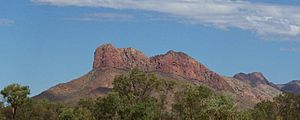Ada Andy Napaltjarri facts for kids
Quick facts for kids
Ada Andy Napaltjarri
|
|
|---|---|
| Born | c.1954 Narwietooma Station, near Haasts Bluff, Northern Territory
|
| Nationality | Australian |
| Known for | Painting |
Ada Andy Napaltjarri (born around 1954) is a talented Indigenous Australian artist. She speaks the Warlpiri and Luritja languages. Ada comes from the Western Desert region of Australia. She was born near Haasts Bluff, Northern Territory. Ada has lived in several communities in the Northern Territory. She started painting in the early 1980s in Alice Springs. Ada likely helped spark interest in painting in the places she lived.
Life Story
Ada Andy was born in 1954. Her birthplace was Narwietooma Station, close to Haasts Bluff, Northern Territory. This area is west of Alice Springs.
Her name includes 'Napaltjarri'. This is a 'skin name'. It's a special name used by central Australian Indigenous people. Skin names help show family connections. They are not like last names in other cultures. 'Ada Andy' is her personal name.
Ada's mother is the artist Entalura Nangala. Her father was Old Andy (Walpa) Tjungarrayi. He was from Karrinyarra Mount Wedge station. He spoke Warlpiri and Anmeterrye languages.
Ada grew up in Haasts Bluff. Later, she lived in Kintore for about nine years. In 1981, Ada was married to Alistair Burns. He was a school teacher from New Zealand. They lived in different communities in the Northern Territory. Ada has three daughters: Maggie, Laati, and Sharon Burns. Her sisters Nora, Emily, and Sallene Andy Napaltjarri are also artists. She also has three brothers: Nigel, Evans, and Randell Andy.
Her Art
How Indigenous Art Started
Modern Indigenous art from the Western Desert began in 1971. Indigenous men in Papunya started painting with help from a teacher, Geoffrey Bardon. They used acrylic paints. Their art showed designs from body painting and ground sculptures. This art quickly became popular across central Australia. A government art program started in 1983. This helped the art spread even more.
By the 1980s and 1990s, this art was shown all over the world. At first, only men painted. There was some hesitation for women to paint. But many women wanted to join in. In the 1990s, many women began creating paintings. People in communities like Kintore and Yuendumu started making art to sell and show.
Ada's Painting Career
Ada Andy started painting around 1981 or 1982. She began her art journey in Alice Springs. When women first started painting with the Papunya Tula art company, Ada Andy was one of the first. She chose to paint on her own. However, some records show she did paint for the company too.
She then lived and painted in communities where her husband taught. These included Mount Allen, Lajamanu, and Willowra. All these places are in the Northern Territory. Some people believe Ada might have helped other people in these communities get interested in painting.
Western Desert artists like Ada often paint special 'dreamings'. These are stories or traditions that they are responsible for. Ada paints stories like the Warumpi Mother and Daughter dreaming. She also paints Women Dancing and Yalka (bush onion) dreaming. Other stories she paints are about black plum, wurrampi (honey ant), and Ngapa (water).


